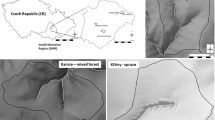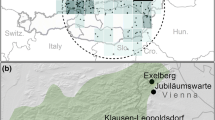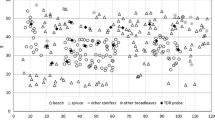Abstract
Water-plant relations play a key role in the water cycling in terrestrial ecosystems. Consequently, changes in tree species composition may have distinct effects on the water retention capacity as well as on the pattern of streamflow generation. Such changes may result from modified interception properties and transpiration related to differences in canopy properties and root distribution. In order to evaluate the potential hydrological effects of the current silvicultural conversion from monocultural conifer stands into mixed or pure deciduous stands the hydrological model BROOK90 was applied to two forested upland catchments in Germany. The Rotherdbach catchment (9.4 ha, 93 yr-old Norway spruce) is situated in the Eastern Ore Mountains. The Schluchsee catchment (11 ha, 55-yr-old Norway spruce) is located in the higher altitudes of the Black Forest. The calibrated model is capable to describe rather well the temporal variation of streamflow but also the portions of the individual flow components. Data for a beech scenario were adapted for each site using a standard parameter set for deciduous trees provided by BROOK90. The annual discharge in the fictional beech stand at Rotherdbach is 30 to 50% higher compared to spruce with an increase of soil moisture and especially the slow streamflow components. This mainly results from low interception rates during winter time. In contrast, the spruce stand has a permanently higher interception rate. Effects of tree species conversion are moderate at Schluchsee. The annual discharge of a fictional beech stand at Schluchsee is 7 to 14% higher compared to spruce. There in contrast to Rotherdbach, effects of tree species conversion on soil moisture dynamics are small since vertical percolation in the highly permeable soil dominates and precipitation is abundant. Practical forestry will favorably establish mixed beech–spruce rather than pure beech stands. However, it is critical to simulate mixed stands with BROOK90. Therefore, a simple summation of model results from spruce and beech according to their respective area in a fictional mixed stand can only be a first approximation. Advanced hydrological simulation of mixed stand conditions should regard interactions of tree species and spatial parameter distribution. However, this is not yet feasible due to a distinct lack of information. As a consequence, there is a strong need to collect relevant hydrological and ecophysiological data in mixed stands in the future.
Similar content being viewed by others
References
Abiy M 1998 Standortskundliche und hydrochemische Untersuchungen in zwei Wassereinzugsgebieten des Osterzgebirges. PhD thesis University of Technology Dresden, 151 pp.
Armbruster M 1998 Zeitliche Dynamik der Wasser-und Elementflüsse in Waldökosystemen. Freiburger Bodenkundl. Abh. 38, 301 pp.
Armbruster M, Abiy M and Feger K H 2003 The biogeochemistry of two forested catchments in the Black Forest and the eastern Ore Mountains (Germany). Biogeochemistry, 65, 341–368.
Bauhus J 1994 Stoffumsätze in Lochhieben. Ber. Forschungszentrum Waldökosysteme der Univ. Göttingen B 72, 181 pp.
Brahmer G 1990 Wasser-und Stoffbilanzen bewaldeter Einzugsgebiete im Schwarzwald unter besonderer Berücksichtigung naturräumlicher Ausstattung und atmogener Einträge. Freiburger Bodenkundl. Abh. 25, 295 pp.
Brooks R H and Corey A T 1964 Hydraulic properties of porous media. Colo. St. Univ. Hydrol. Pap. 3, 1–27.
Buczko U, Bens O, Fischer H and Hüttl R F 2002 Water repellency in sandy luvisols under different forest transformation stages in northeast Germany. Geoderma 109, 1–18.
Dengler A 1992 Waldbau. Der Wald als Vegetationsform und seine Bedeutung für den Menschen. Vol. 1, Parey, Hamburg Berlin, Germany, 350 pp.
Federer C A 1995 BROOK90-A simulation model for evapotranspiration, soil water and streamflow, Version 3.24. Computer freeware and documentation, USDA, Forest Service, Durham, USA.
Federer C A 2002 BROOK90-A simulation model for evaporation, soil water, and streamflow. Documentation for versions 4 and 3.2/3/4. http://users.rcn.com/compassbrook/b90doc.html.
Feger K H 1993 Bedeutung von ökosysteminternen Umsätzen und Nutzungseingriffen für den Stoffhaushalt von Waldlandschaften. Freiburger Bodenkundl. Abh. 31, 237 pp.
Hager H 2002 SRP Forest Ecosystem Restoration – Final Report, Project part: Stand climate and forest hydrology and their alternations by measures of forest ecosystem restoration. BOKU University Vienna.
Hammel K and Kennel M 2001 Charakterisierung und Analyse der Wasserverfügbarkeit und des Wasserhaushalts von Waldstandorten in Bayern mit dem Simulationsmodell BROOK90. Forstliche Forschungsberichte München 185, 148 pp.
IfW (Institut für Waldbau der Georg-August-Universität) 1987 Die einheimischen und die wichtigsten fremdländischem Baumarten. Institut für Waldbau, Abteilung für Waldbau der Tropen und Naturwaldforschung, Göttingen, 273 pp.
Kennel M 1998 Modellierung des Wasser-und Stoffhaushaltes von Waldökosystemen. Fallstudien: Forsthydrologisches Forschungsgebiet Krofdorf, Referenzeinzusgebiet Große Ohe. Forstliche Forschungsberichte München 168, 361 pp.
Kern K G, Moll W and Braun H J 1961 Wurzeluntersuchungen in Rein-und Mischbeständen des Hochschwarzwaldes (Vfl. Todmoos 2/I-IV). Allg. Forst Jagdztg. 132, 241–129.
Küßner R 1998 Ein auf Strahlungsmessung basierendes Verfahren zur Bestimmung des Blattflächenindexes und zur Charakterisierung der Überschirmung in Fichtenaltbeständen. Forstwiss. Beiträge Tharandt (Contributions to Forest Science) 5, Ulmer, Stuttgart, Germany, 198 pp.
Larcher W 1994 Ökologie der Pflanzen auf physiologischer Grundlage. Ulmer, Stuttgart, Germany, 294 pp.
Matzner E 1988 Der Stoffumsatz zweier Waldökosysteme im Solling. Ber. des Forschungszentrums Waldökosyst. D. Univ. Göttingen, Reihe A, Bd. 41.
Matzner E 1998 ZumVerhalten von Waldökosystemen bei veränderten Umweltbedingungen.-Zusammenfassender Bericht über die Förderperiode 1995-1997. In BITÖK-Forschungsberichte 1995– 97, Bayreuther Institut für Terrestrische Ökosystemforschung (Hrsg.). Bayr. For. Ökologie 58, 3–16.
Nebe W, Roloff A and Vogel M (Eds) 1998 Untersuchung von Waldökosystemen im Erzgebirge als Grundlage für einen ökologisch begründeten Waldbau. Forstwiss. Beiträge Tharandt (Contributions to Forest Science) 4, Ulmer, Stuttgart, Germany, 255 pp.
Raspe S 1992 Biomasse und Mineralstoffgehalte der Wurzeln von Fichtenbeständen (Picea abies Karst.) des Schwarzwaldes und Veränderung nach Düngung. Freiburger Bodenkundl. Abh. 29, 197 pp.
Rothe A 1997 Einfluss des Baumartenanteils auf Durchwurzelung, Wasserhaushalt, Stoffhaushalt und Zuwachsleistung eines Fichten-Buchen-Mischbestandes am Standort Höglwald. Forstl. Forschungsber. München 163.
Rothe A and Binkley D 2001 Nutritional interactions in mixed species forests: a synthesis. Can. J. For. Res. 31, 1855–1870.
Rothe A, Huber C, Kreuzer K and Weis W 2002a Deposition and soil leaching in stands of Norway spruce and European Beech: Results from the Höglwald research in comparison with other European case studies. Pant Soil 240, 33–45.
Rothe A, Kreutzer K, Küchenhoff H 2002b Influence of tree species composition on soil solution properties in two mixed spruce-beech stands with contrasting history in Southern Germany. Plant Soil 240, 47–56.
Sambale Ch 1998 Experimentelle und modellgestützte Wasserhaushaltsuntersuchungen im System Boden-Pflanze-Atmosphäre. Internationales Hochschulinstitut Zittau, IHI-Schriften 8.
Schäfer B, Bens O, Fischer H and Hüttl R F 2002 Einfluss des Baumartenwechsels auf die Wasserspeicherfähigkeit von sandigen Böden den Nordost-Deutschlands. Forst Holz 19, 571–575.
Schmid I and Kazda M 2001 Vertical distribution and radial growth of coarse rots in pure and mixed stands of Fagus sylvatica and Picea abies. Can. J. For. Res. 31, 539–548.
Schmid I and Kazda M 2002 Root distribution of Norway spruce in monospecific and mixed stands on different soils. For. Ecol. Manage. 159, 37–47.
Schume H, Jost G and Katzensteiner K 2003 Spatio-temporal analysis of the soil water content in a mixed Norway spruce (Picea abies (L.) Karst.)-European beech (Fagus sylvatica L.) stand. Geoderma 112, 273–287.
Schwarze R, Hermann A, Münch A, Grünewald U and Schöniger M 1991 Rechnergestützte Analyse von Abflußkomponenten und Verweilzeiten in kleinen Einzugsgebieten. Acta Hydrophys. 35, 143–184.
Shuttleworth W J and Wallace J S 1985 Evaporation from sparse crops-an energy combination theory. Quart. J. Royal Meteorol. Soc. 111, 839–855.
Zimmermann L 1995 Der Bodenwasserhaushalt an einem Hochlagenstandort im Südschwarzwald. Freiburger Bodenkundl. Abh. 35, 206 pp.
Author information
Authors and Affiliations
Rights and permissions
About this article
Cite this article
Armbruster, M., Seegert, J. & Feger, KH. Effects of changes in tree species composition on water flow dynamics – Model applications and their limitations. Plant Soil 264, 13–24 (2004). https://doi.org/10.1023/B:PLSO.0000047716.45245.23
Issue Date:
DOI: https://doi.org/10.1023/B:PLSO.0000047716.45245.23




